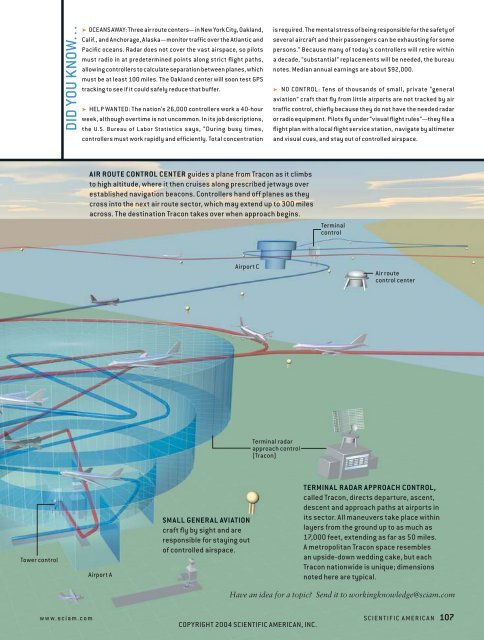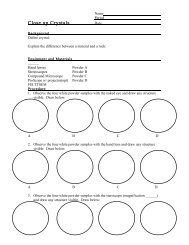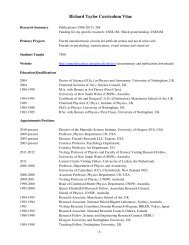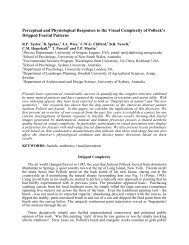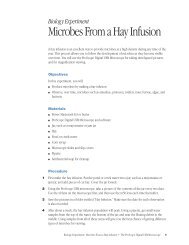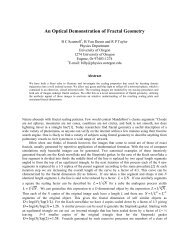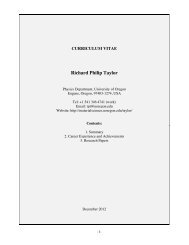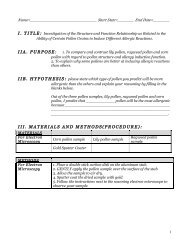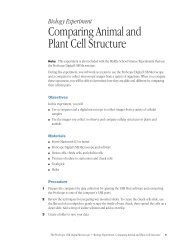December 2004 - Materials Science Institute - University of Oregon
December 2004 - Materials Science Institute - University of Oregon
December 2004 - Materials Science Institute - University of Oregon
You also want an ePaper? Increase the reach of your titles
YUMPU automatically turns print PDFs into web optimized ePapers that Google loves.
Tower control<br />
DID YOU KNOW...<br />
➤ OCEANS AWAY: Three air route centers—in New York City, Oakland,<br />
Calif., and Anchorage, Alaska—monitor traffi c over the Atlantic and<br />
Pacifi c oceans. Radar does not cover the vast airspace, so pilots<br />
must radio in at predetermined points along strict fl ight paths,<br />
allowing controllers to calculate separation between planes, which<br />
must be at least 100 miles. The Oakland center will soon test GPS<br />
tracking to see if it could safely reduce that buffer.<br />
➤ HELP WANTED: The nation’s 26,000 controllers work a 40-hour<br />
week, although overtime is not uncommon. In its job descriptions,<br />
the U.S. Bureau <strong>of</strong> Labor Statistics says, “During busy times,<br />
controllers must work rapidly and effi ciently. Total concentration<br />
AIR ROUTE CONTROL CENTER guides a plane from Tracon as it climbs<br />
to high altitude, where it then cruises along prescribed jetways over<br />
established navigation beacons. Controllers hand <strong>of</strong>f planes as they<br />
cross into the next air route sector, which may extend up to 300 miles<br />
across. The destination Tracon takes over when approach begins.<br />
Airport A<br />
Airport C<br />
SMALL GENERAL AVIATION<br />
craft fl y by sight and are<br />
responsible for staying out<br />
<strong>of</strong> controlled airspace.<br />
is required. The mental stress <strong>of</strong> being responsible for the safety <strong>of</strong><br />
several aircraft and their passengers can be exhausting for some<br />
persons.” Because many <strong>of</strong> today’s controllers will retire within<br />
a decade, “substantial” replacements will be needed, the bureau<br />
notes. Median annual earnings are about $92,000.<br />
➤ NO CONTROL: Tens <strong>of</strong> thousands <strong>of</strong> small, private “general<br />
aviation” craft that fl y from little airports are not tracked by air<br />
traffi c control, chiefl y because they do not have the needed radar<br />
or radio equipment. Pilots fl y under “visual fl ight rules”—they fi le a<br />
fl ight plan with a local fl ight service station, navigate by altimeter<br />
and visual cues, and stay out <strong>of</strong> controlled airspace.<br />
Terminal radar<br />
approach control<br />
(Tracon)<br />
Terminal<br />
control<br />
Air route<br />
control center<br />
TERMINAL RADAR APPROACH CONTROL,<br />
called Tracon, directs departure, ascent,<br />
descent and approach paths at airports in<br />
its sector. All maneuvers take place within<br />
layers from the ground up to as much as<br />
17,000 feet, extending as far as 50 miles.<br />
A metropolitan Tracon space resembles<br />
an upside-down wedding cake, but each<br />
Tracon nationwide is unique; dimensions<br />
noted here are typical.<br />
Have an idea for a topic? Send it to workingknowledge@sciam.com<br />
www.sciam.com SCIENTIFIC AMERICAN 107<br />
COPYRIGHT <strong>2004</strong> SCIENTIFIC AMERICAN, INC.


